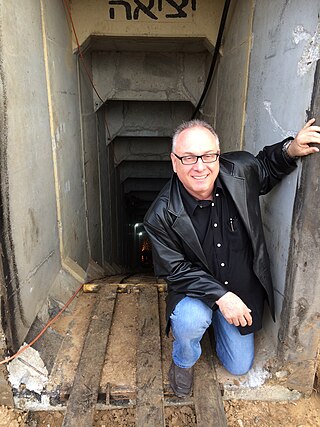
Beachwood is a city in eastern Cuyahoga County, Ohio, United States. As of the 2020 census the city's population was 14,040. A suburb of Cleveland, it is a part of the Cleveland metropolitan area.

Yad Vashem is Israel's official memorial to the victims of the Holocaust. It is dedicated to preserving the memory of the Jews who were murdered; echoing the stories of the survivors; honoring Jews who fought against their Nazi oppressors and gentiles who selflessly aided Jews in need; and researching the phenomenon of the Holocaust in particular and genocide in general, with the aim of avoiding such events in the future. Yad Vashem's vision, as stated on its website, is: "To lead the documentation, research, education and commemoration of the Holocaust, and to convey the chronicles of this singular Jewish and human event to every person in Israel, to the Jewish people, and to every significant and relevant audience worldwide."
Events from the year 1988 in art.

Judith Leiber was a Hungarian-American fashion designer and businesswoman.

Abba Hillel Silver was an American Rabbi and Zionist leader. He was a key figure in the mobilization of American support for the founding of the State of Israel.
The Holocaust has been a prominent subject of art and literature throughout the second half of the twentieth century. There is a wide range of ways–including dance, film, literature, music, and television–in which the Holocaust has been represented in the arts and popular culture.

The Maltz Museum is a private non-profit museum in the Cleveland suburb of Beachwood that celebrates the history of the Jewish community of Greater Cleveland and Northeast Ohio, as well as the diversity of the human experience. Opened on October 11, 2005, the Maltz Museum features two permanent collections, An American Story and The Temple - Tifereth Israel Gallery, in which personal stories are brought to life through film, computer interactives, special effects and exhibitions that feature artefacts, art, documents and images. The Museum also hosts rotating exhibitions, as well as weekly public programs.
The Temple Tifereth-Israel was a Reform Jewish congregation and synagogue, located at 26000 Shaker Boulevard, in Beachwood, a suburb of Cleveland, Ohio, in the United States. The synagogue was a member of the Union for Reform Judaism. On 1 July 2024, Tifereth-Israel merged with Anshe Chesed Fairmount Temple to create a new Reform congregation, Mishkan Or, located at the site of Tifereth-Israel.

The Maltz Performing Arts Center, officially the Milton and Tamar Maltz Performing Arts Center, is a 1200-seat historic arts and religious venue on the campus of Case Western Reserve University, located at 1855 Ansel Road, in Cleveland, Ohio, in the United States. The center is contained within the Temple–Tifereth Israel synagogue building, located at Silver Park, on the border between the suburbs of Hough and University Circle.

Sam Philipe is an Israeli sculptor. He is known for his sculptures of biblical and New Testament figures.
Anshe Chesed Fairmount Temple, commonly called the Fairmount Temple, was a Reform Jewish congregation and synagogue, located at 23737 Fairmount Boulevard, in Beachwood, Ohio, in the United States. The congregation was the oldest Jewish congregation in the Cleveland area through mid-2024. The congregation's membership exceeded 2,000 families in the mid-1990s.
Naomi Wilzig was an American erotic art collector. She was the founder and director of the World Erotic Art Museum in Miami Beach, Florida, which contains her collection.

This large, mid-19th century Moroccan wall hanging, or haiti, is a highlight of the textile collection of the Indianapolis Museum of Art, which is in Indianapolis, Indiana. Made in the cultural center of Fez, it is crafted of the finest materials: silk velvet embroidered with gold metallic thread.

Morton Leon Mandel was an American business magnate, entrepreneur, and philanthropist. Along with his two brothers, Jack and Joe, he founded the Premier Automotive Supply Company in 1940, which later became one of the world's leading industrial parts and electronic components distributors. His philanthropic activities in Cleveland, and in Jewish and Israeli institutions, were via the Mandel Foundation.

Kopel Gurwin (1923–1990) was an Israeli wall hanging artist, painter and graphic artist.

The Jewish community of the Greater Cleveland area comprises a significant ethnoreligious population of the U.S. State of Ohio. It began in 1839 by immigrants from Bavaria and its size has significantly grown in the decades since then. In the early 21st century, Ohio's census data reported over 150,000 Jews, with the Cleveland area being home to more than 50% of this population. As of 2018, Greater Cleveland is the 23rd largest Jewish community in the United States. As of 2023, the Cleveland Jewish Community is estimated to be about 100,000 people.

Mayfield Cemetery is a historic Jewish cemetery located at 2749 Mayfield Road in Cleveland Heights, Ohio. Established in 1890, it is one of the largest Jewish cemeteries in Cuyahoga County and the only Jewish garden cemetery. A chapel was constructed in 1893. This was demolished and a large mausoleum, which included a chapel, was built in 1930.
Judith Weinshall Liberman is an Israeli artist who is known for the Holocaust Wall Hangings, a series of sixty loose-hanging fabric banners of varying sizes created between 1988 and 2002 depicting the plight of the Jewish people and other minorities during the Holocaust of World War II.













